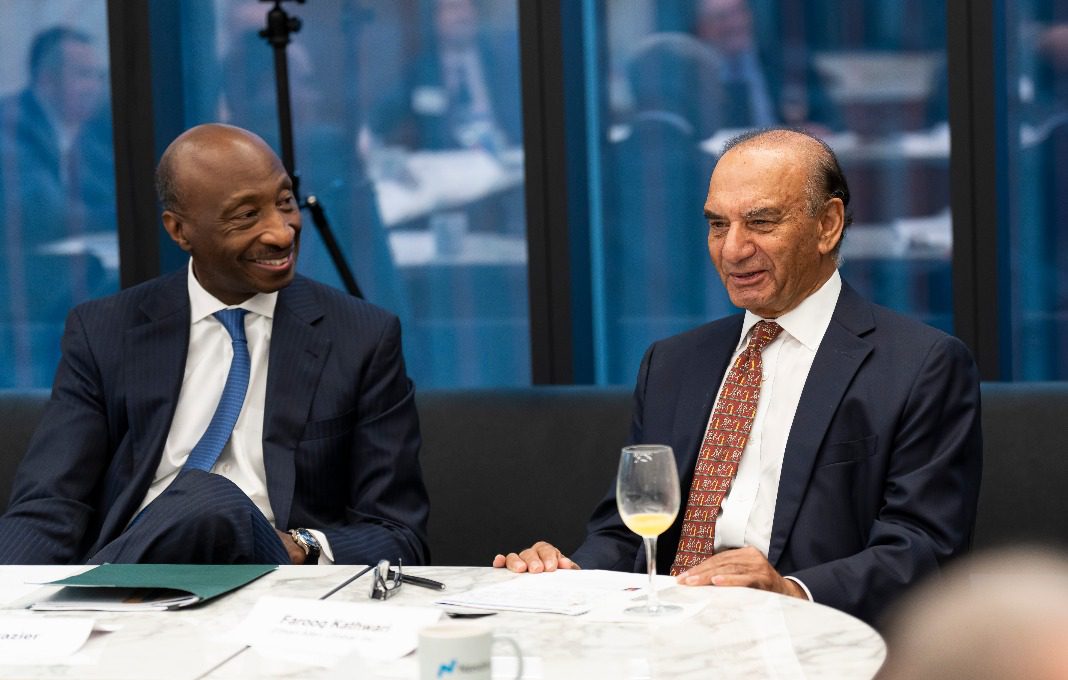“We’ve all lived in uncertain times,” Ethan Allen CEO Farooq Kathwari told fellow leaders at a roundtable cosponsored by Chief Executive and PURE Insurance. “It’s just relative—some times are more uncertain than others.”
Market volatility, high inflation, impending recession, geopolitical uncertainty, labor shortages and climate change are just a few of the challenges facing leaders today. Together, they conspire to make scenario planning much more difficult, said Ross Buchmueller, president and CEO of PURE Insurance. As an example, he pointed to changes in climate that have roiled his industry. While hurricane losses are expected, “what’s not expected is 20 degree weather in Texas with the power grid failing and $40 billion of losses emerging out of something that was in nobody’s event set,” he said. “If you take the losses where you expected them, you move on in a rational way. But when, all of a sudden, the losses come in things that you did not predict, it just leads you to be cautious and not willing to commit.”
Risks Abound
Global geopolitical instability is one of the top factors contributing to CEO angst, agreed roundtable attendees. “The U.S. is probably going to have a resilient economy in the face of recession, but I’m not so sure about China, I’m not so sure about Europe,” said Kenneth Frazier, retired chairman and CEO of Merck. “Other than the United States, [Merck’s] customers are countries who are struggling with their own economic and monetary challenges.”
Frazier added, however, that it’s not only global turbulence, such as the war in Ukraine and declining relations with China, that is problematic, but political challenges stateside, as well. The Inflation Reduction Act, for example, created price controls that will wreak havoc on ROI for pharmaceuticals. “Forty percent of the scientific programs we have underway at Merck would become NPV-negative” under the act, said Frazier. “It’s really amazing to me, because it seemed like just yesterday the industry was being lauded for vaccines and monoclonal antibodies and therapeutics for Covid, allowing the world to come back into session—but that didn’t last very long.”
Though the world returning to some normalcy has helped, navigating the hurdles of “a completely distributed workforce” makes leadership that much more challenging, said Karan Yaramada, CEO of Jade Global.
“How do you build a culture when you can’t meet people, can’t engage them emotionally? And then, how do you innovate? How do you achieve customer success? Because you cannot have customer success and innovation without people collaborating in person and engaging emotionally.”
A New World
Jeff Baxter, CEO of VBI Vaccines, agreed, but noted that the demand for remote work options is likely not going to change any time soon. “The ship has sailed for the people working flexibly, I can’t see how we can turn that clock back. I personally can’t—office workers now expect it,” he said, adding that his biggest challenge as a manufacturer is managing the resentment between those who have to work in person because of the nature of their jobs and those working remotely.
August Vlak, president and CEO of the Eastern Company, said he solved that problem by not creating two classes of workers. “If factory workers have to come in, office workers have to come in. We did that because we didn’t want to have to reset the standards,” he said.
At high-end furniture maker Ethan Allen, Kathwari also largely maintained the same standards for manufacturing labor and interior designers; the latter communicate with customers via technology but typically do so from the company’s design centers, where customers can see fabrics and colors. “Combining technology and personal service has become a very important factor to our business,” he said, adding that a small percentage of jobs at corporate headquarters have the flexibility to work from home two days a week, depending on the nature of the job. “[It’s] working well for us.”
Labor, Pains
Whichever way a company has gone with remote vsersus in-person work, CEOs agreed that the tight labor market has given employees more control. “I saw a data point the other day that said 85 percent of CEOs think people need to be at work in order to have culture and innovation and all those things, and 85 percent of employees think they do more work remotely than they did in the office. That’s a real mismatch in expectations,” Frazier said. “At the end of the day, we’re only as good as the people who come in and work for us, so I think we’ve got to really address this issue.”
To do that, leaders will first have to reckon with changing priorities among the newest generation of workers. “I see these trends of how the new entrants to the workforce, and particularly to professional services, have really, really changed, and I wonder whether it will change back a little bit at some point,” said Mark Billige, CEO of Simon-Kucher & Partners, where the average age of employees is 28 to 29 years old. He added that when he started out in professional services, while people were interested in the business purpose and motivated to do good work, at the end of the day, they also had mortgages to pay and life requirements to meet. “Now I’m always fascinated by the number of young people I meet who say, ‘Hey, listen, I don’t need a job, I can do something else, I can rent somewhere.’ And those kinds of other priorities of a whole generation are changing massively, which I think it gives us, and will for everyone eventually, some things to think about as a generation of workers tell us they now value completely different things.”
It’s a puzzle CEOs will have to figure out given the skills shortage, said Byrne Mulrooney, CEO of Korn Ferry’s recruitment process outsourcing and digital businesses. “There are concerns about a recession, but you still have a constrained labor environment, right? You have a huge skills shortage. That creates pressure points in firms that they never really felt before.”
Young people’s changing expectations may have another consequence: They don’t want to double their tuition debt by getting an MBA, which means they won’t want to leave their positions to go back to school. If undergraduate business degrees flourish, he said, fewer employees will have to do that. “If we do a good job with people 18 to 22, they’re not going to have to go back to school,” he said.
Seeing the Opportunities
Particularly in times of uncertainty, when so many companies are idling and waiting out the current climate, those willing to take some risks have a chance to come out ahead. “I think we’re in an expectation recession,” said Brad Jackson, CEO of Slalom. “Many of our customers are giving us more grace than they ever have. And after all these years of increasing expectations, I think we’re also giving more grace to those companies in our lives that we buy products and services from, so what an incredible opportunity to do something with that.”
The expectation recession, he said, has led to some companies relaxing their focus on customers. “We’re all very focused on supply chain, geopolitical, relationships with employees, and there’s almost zero dialogue with CEOs anymore around customer centricity. For many of us, if we look at our calendars, it’s way less time physically with our customers than it was before the pandemic,” he said.
All of that means that for those that do turn their attention to customers, “it’s going to be one of the greatest leapfrog opportunities in our lifetime.”
Given lower valuations and higher interest rates restricting access to capital, it may be a good time for acquisitions, as well. “Quite frankly, if you look at the risk in the capital markets at the moment and how that’s rewarding biotech, there are over 200 biotech companies at the moment that are trading below cash. For me, that creates an opportunity,” Jackson said. “We’ve acquired two companies, and we’re looking at acquiring more. Some of these companies, they IPO-ed two years ago at several hundred million. There’s one company I won’t name, but their market cap today is $24 million. Nothing is at fault, the core science is still there, they’ve got $43 million in the bank and it’s synergistic with us—so why not?”
The Voice of Optimism
It’s also a good time for reinvention, noted Simon Freakley, CEO of AlixPartners, which, in its most recent annual CEO survey, found that 94 percent were planning to change their business model within the next three years.
Freakley also pointed to a stat from the same AlixPartners CEO survey: “When we asked them, ‘are they fearful about losing their jobs?’ the number of chief executives this year who felt that they were at risk was 20 percentage points higher than last year,” he said. “The uncertainty of changing business models and the anxiety of senior executives and their tenure—I don’t think they’re unrelated.”
Through all that uncertainty, CEOs must also be the voice of optimism for their people. “It’s a lonely job,” said Jerry Jabbour, CEO of Matinas BioPharma. “You always have to be the flag bearer, you have to be positive all the time. That’s not easy.”
Vlak pointed out one of the biggest challenges of all: telling the difference between short-term, temporary challenges, “which include everything from supply chain to raw material inflation to share price,” and the sort of seismic disruption that can fell companies that don’t see it coming. “Can I, on the one hand, keep a steady hand on the tiller and focus on execution when they feel like temporary disruptions, and on the other hand really try to question the assumptions about how we serve customers and build products?” he asked. “I would say that’s probably the hardest challenge I have to navigate through every day.”
























































![Key Metrics for Social Media Marketing [Infographic] Key Metrics for Social Media Marketing [Infographic]](https://www.socialmediatoday.com/imgproxy/nP1lliSbrTbUmhFV6RdAz9qJZFvsstq3IG6orLUMMls/g:ce/rs:fit:770:435/bG9jYWw6Ly8vZGl2ZWltYWdlL3NvY2lhbF9tZWRpYV9yb2lfaW5vZ3JhcGhpYzIucG5n.webp)


















